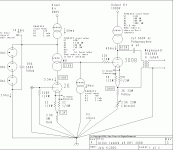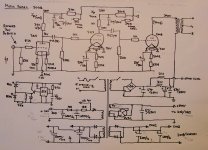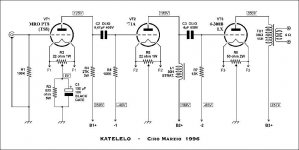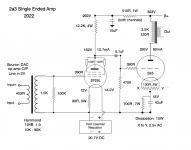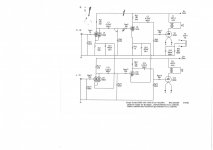This thread has the goal of collecting schematics, pictures and comments of any kind about amplifiers where ALL the signal tubes are directly heated - both input and output tubes. The only indirectly heated tubes allowed will be in the power supply or support positions e.g. rectifiers or active loads. Can be push-pull or single ended, and directly heated pentodes are also allowed, in triode or pentode.
Since the majority of directly heated tubes are fairly low mu (up to 15) it is likely that designs will include 3 stage amplifiers or 2 stage amplifiers with step-up transformers in the input or interstage. Maybe also some other creative solutions.
So please post your ideas, schematics and comments of any kind and let's make this thread an interesting one!
To kick off, here's a design by Ale Moglia titled "300B SE Amp: 47 Driver: Going DHT end to end"
https://www.bartola.co.uk/valves/2020/07/25/300b-se-amp-47-driver/
Since the majority of directly heated tubes are fairly low mu (up to 15) it is likely that designs will include 3 stage amplifiers or 2 stage amplifiers with step-up transformers in the input or interstage. Maybe also some other creative solutions.
So please post your ideas, schematics and comments of any kind and let's make this thread an interesting one!
To kick off, here's a design by Ale Moglia titled "300B SE Amp: 47 Driver: Going DHT end to end"
https://www.bartola.co.uk/valves/2020/07/25/300b-se-amp-47-driver/
Here's a couple of designs using the 4P1L as output stage. First Ale Moglia, in PSE.
https://www.bartola.co.uk/valves/2017/02/05/4p1l-pse-amp-finished/
And here a thread on 4P1L driving PP 4P1L through an interstage splitter. With its mu of around 11 it's useful for a 2 stage amp.
https://www.hifivision.com/threads/my-new-all-dht-amplifier.39687/
And here a thread on ideas for an all-DHT amp:
https://www.diyaudio.com/community/threads/help-on-designing-full-dht-set-power-amplifier.194228/
https://www.bartola.co.uk/valves/2017/02/05/4p1l-pse-amp-finished/
And here a thread on 4P1L driving PP 4P1L through an interstage splitter. With its mu of around 11 it's useful for a 2 stage amp.
https://www.hifivision.com/threads/my-new-all-dht-amplifier.39687/
And here a thread on ideas for an all-DHT amp:
https://www.diyaudio.com/community/threads/help-on-designing-full-dht-set-power-amplifier.194228/
Here is a commercial design - Allnic A-5000 from Hammertone Audio. It uses HL-2 > RS242 > 300B
https://www.hammertoneaudio.com/product/a-5000-dht-monoblock-amplifier
And here is a lovely build by Thomas Mayer - 10Y/45 drives 45/2a3
https://vinylsavor.blogspot.com/2014/03/the-10y-45-drives-45-2a3-amplifier.html
https://www.hammertoneaudio.com/product/a-5000-dht-monoblock-amplifier
And here is a lovely build by Thomas Mayer - 10Y/45 drives 45/2a3
https://vinylsavor.blogspot.com/2014/03/the-10y-45-drives-45-2a3-amplifier.html
Last edited:
Don't understand why do you need source follower after a 30 mA driver.This thread has the goal of collecting schematics, pictures and comments of any kind about amplifiers where ALL the signal tubes are directly heated - both input and output tubes. The only indirectly heated tubes allowed will be in the power supply or support positions e.g. rectifiers or active loads. Can be push-pull or single ended, and directly heated pentodes are also allowed, in triode or pentode.
Since the majority of directly heated tubes are fairly low mu (up to 15) it is likely that designs will include 3 stage amplifiers or 2 stage amplifiers with step-up transformers in the input or interstage. Maybe also some other creative solutions.
So please post your ideas, schematics and comments of any kind and let's make this thread an interesting one!
To kick off, here's a design by Ale Moglia titled "300B SE Amp: 47 Driver: Going DHT end to end"
https://www.bartola.co.uk/valves/2020/07/25/300b-se-amp-47-driver/
That's a good question.Don't understand why do you need source follower after a 30 mA driver.
Have you built an all-DHT amp yet? I know it's on your mind.
This is layout for main amplifier board - without output tubes. Drilling and punching the chassis, putting things together. It proceeds slower than I would like. A lot of distractions. Haven't yet started with firewood for the winter.
When I get time I'll go through my schematics more. Here is a start. Not sure if any are proven. Here is what I have for 45's.




Thanks for some interesting circuits! The US tube era designs often seem to use the 45. Later circuits start using the Soviet tubes - 4P1L, 2P29L, 6C4C, GM-70 and so forth. You also see filament bias (Thomas Mayer) starting to appear in the later designs, together with Rod Coleman filament regs.
Interesting to see the Lundahl LL1660 used as a plate choke. I did this myself since I thought it sounded better that way with a FT-3 teflon coupling cap.
There are a few European DHTs which you don't see often, like PX25, PX4, AD1, HL-2 and several more obscure ones.
And then there are the high voltage tubes like 813, 845, 211 etc.
Interesting to see the Lundahl LL1660 used as a plate choke. I did this myself since I thought it sounded better that way with a FT-3 teflon coupling cap.
There are a few European DHTs which you don't see often, like PX25, PX4, AD1, HL-2 and several more obscure ones.
And then there are the high voltage tubes like 813, 845, 211 etc.
Attachments
Last edited:
Shouldn't there be a decoupling capacitor to ground at the bottom of the secondary winding of the Lundahl transformer? The output valve is now driven from a > 470 kohm impedance (assuming the Lundahl transformer still works as a transformer and the signal is not coupled via the capacitance between its primary and secondary windings).
The kind of directly heated tubes nobody is talking about are Russian rod pentodes. These tubes have super efficient filaments that can be practically run on one or two NiCd batteries, making clumsy DC filament supplies unnecessary. Here are three of these tubes particularly suitable for audio in triode connection:
1J24B
100 V 1.5 mA mu=20 Rp=16 K. Filament 1.2 V 13 mA.
1J29B
150 V 8 mA mu=10 Rp=4 K. Filament 1.2 V 60 mA or 2.4 V 30 mA. This has characteristics of beefed-up 01A.
1P24B
150 V 25 mA mu=8 Rp=2.5 K. Filament 1.2 V 240 mA or 2.4 V 120 mA. Max ratings - Ua=300 V, Ik=40 mA, Pa=4 W, Pg2=1.5 W. It can be used as SET output for about 700 mW, or as driver.
They all have nice triode curves. They are dirt cheap. I bought batches of them for less than dollar apiece.
1J24B
100 V 1.5 mA mu=20 Rp=16 K. Filament 1.2 V 13 mA.
1J29B
150 V 8 mA mu=10 Rp=4 K. Filament 1.2 V 60 mA or 2.4 V 30 mA. This has characteristics of beefed-up 01A.
1P24B
150 V 25 mA mu=8 Rp=2.5 K. Filament 1.2 V 240 mA or 2.4 V 120 mA. Max ratings - Ua=300 V, Ik=40 mA, Pa=4 W, Pg2=1.5 W. It can be used as SET output for about 700 mW, or as driver.
They all have nice triode curves. They are dirt cheap. I bought batches of them for less than dollar apiece.
"Since the directly heated driver tubes have low gain, an input transformer steps up the voltage 1:4."And here is a lovely build by Thomas Mayer - 10Y/45 drives 45/2a3
https://vinylsavor.blogspot.com/2014/03/the-10y-45-drives-45-2a3-amplifier.html
- Home
- Amplifiers
- Tubes / Valves
- All-DHT amplifiers: no indirectly heated signal tubes!
